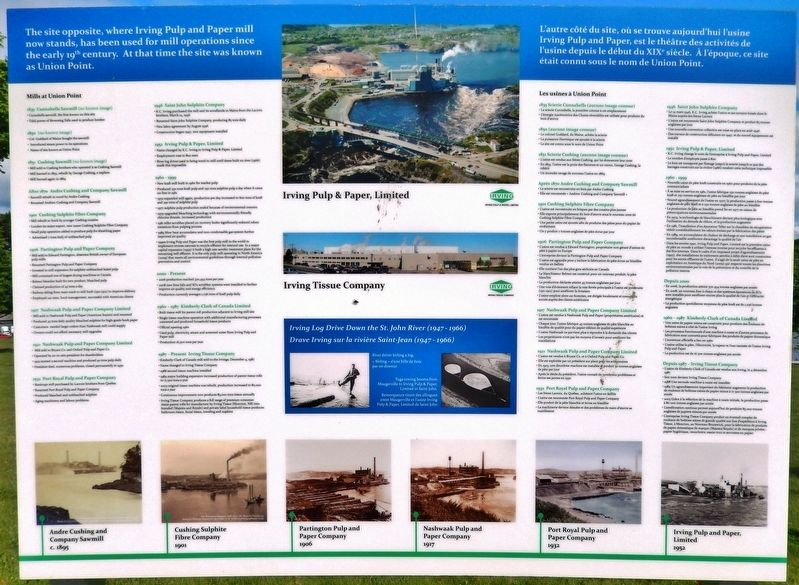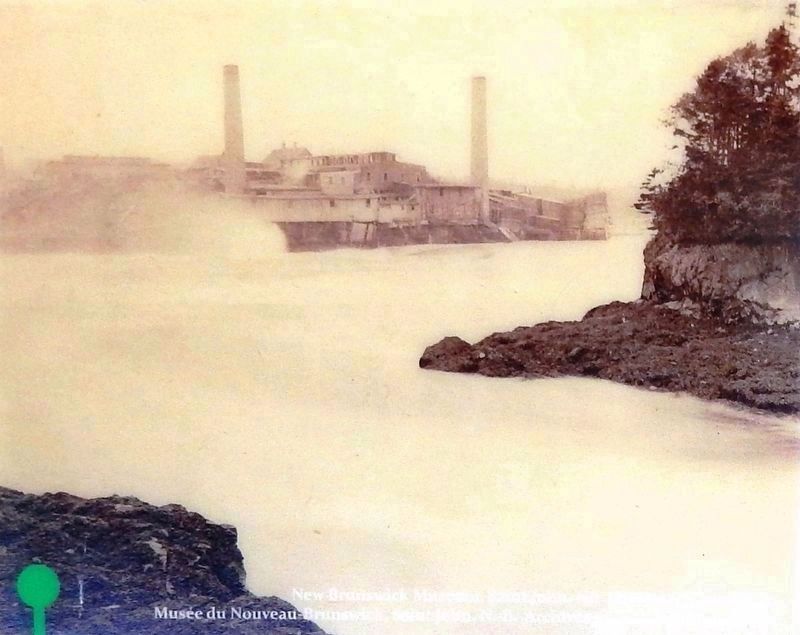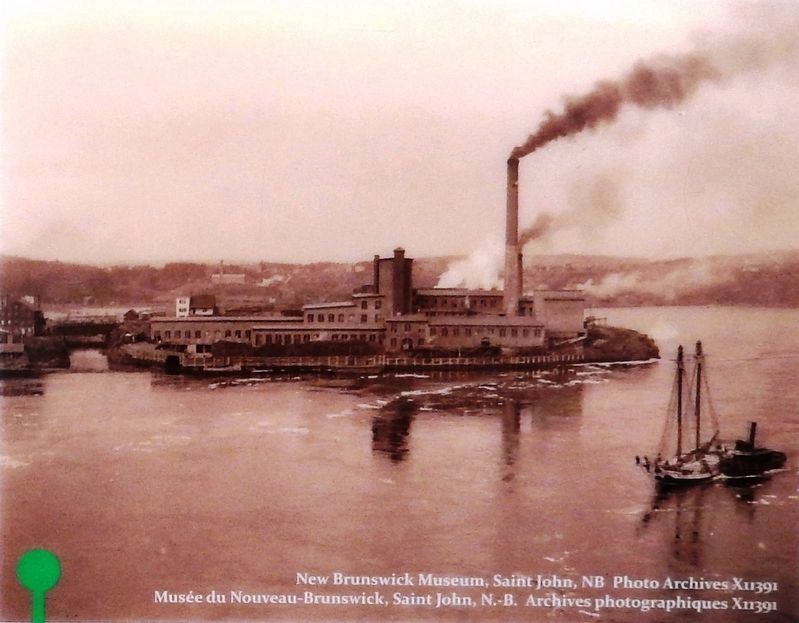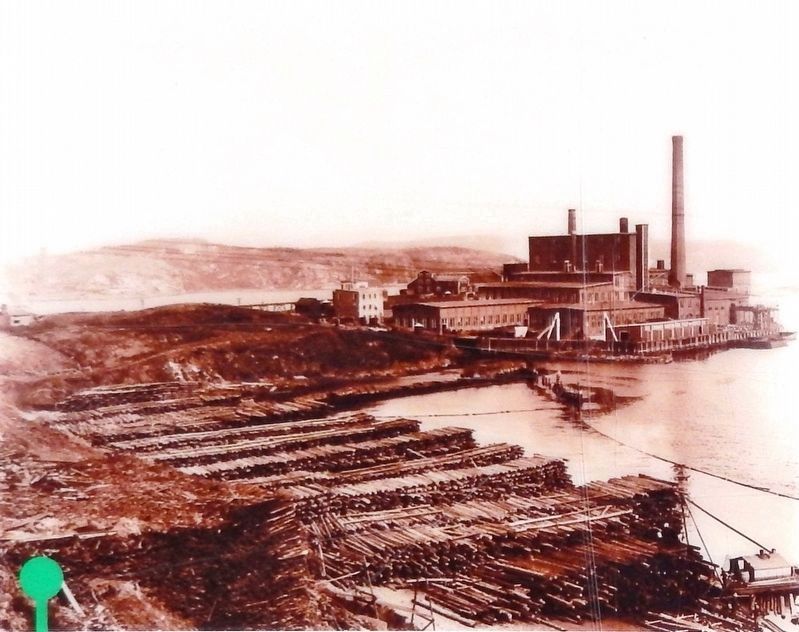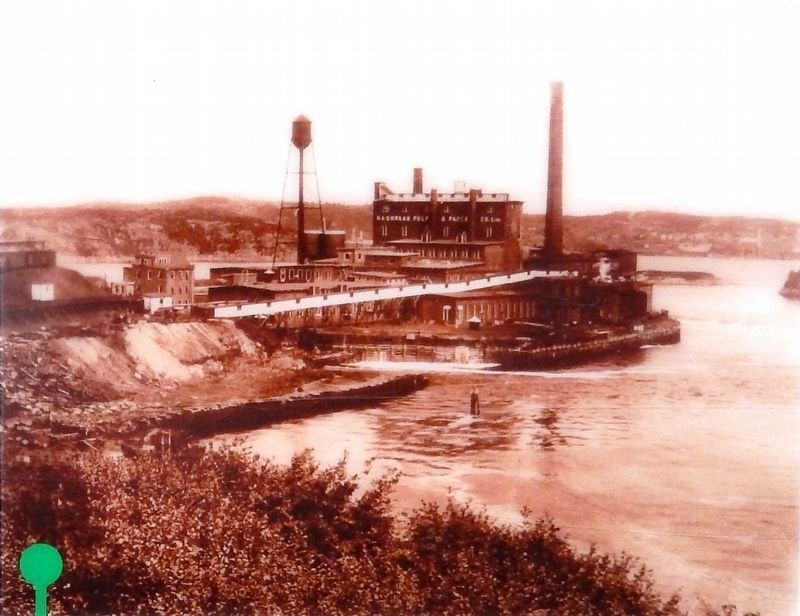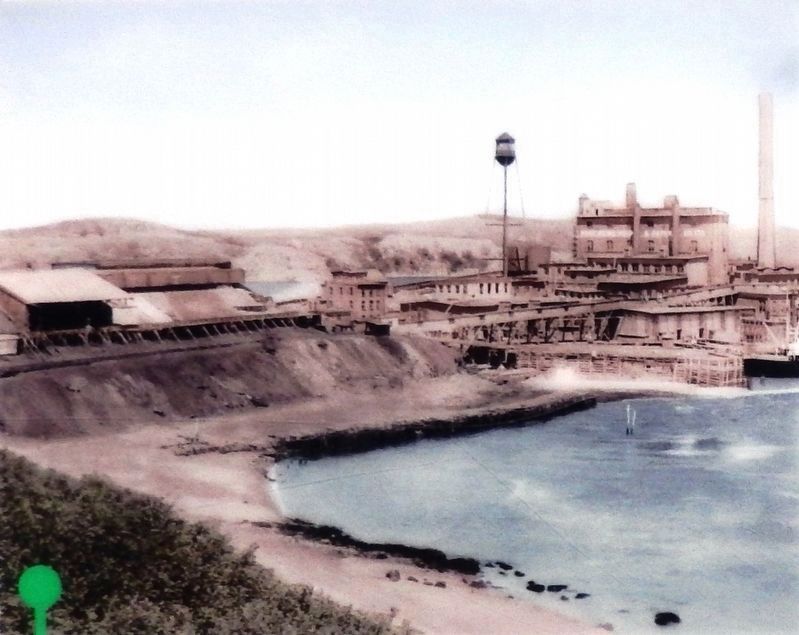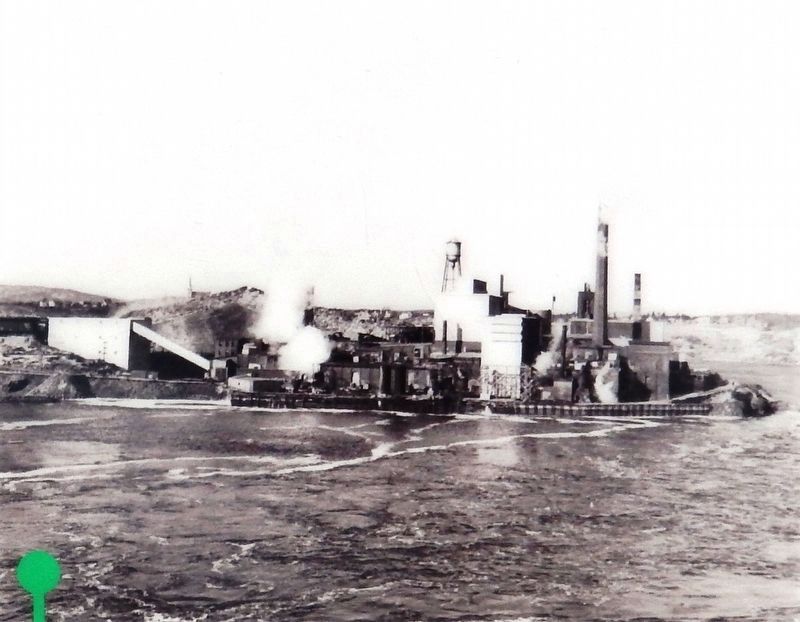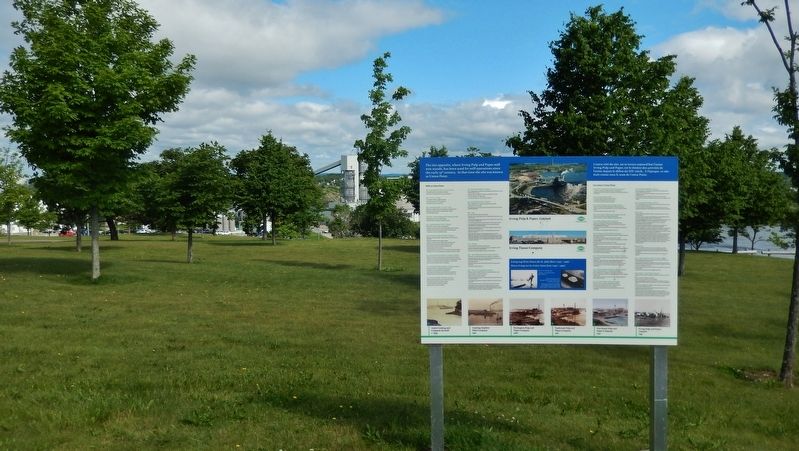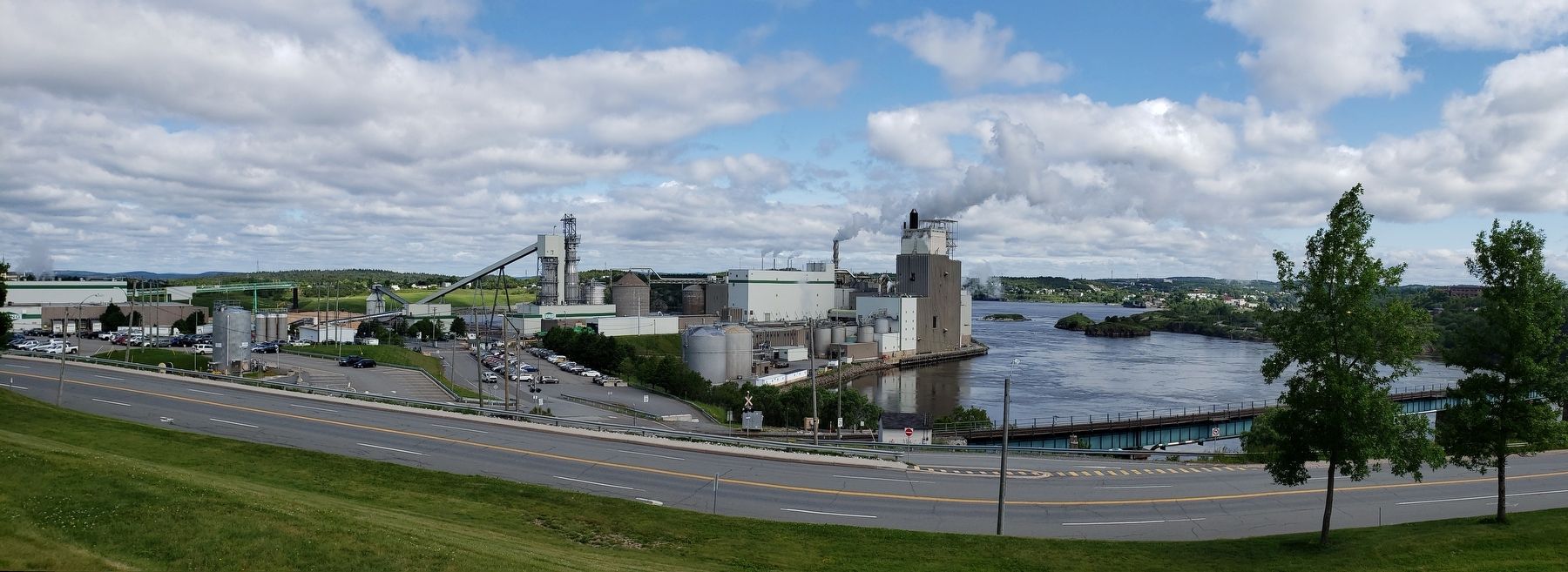Saint John in Saint John County, New Brunswick — The Atlantic Provinces (North America)
Mills at Union Point
Les usines à Union Point
Inscription.
The site opposite, where Irving Pulp and Paper mill now stands, has been used for mill operations since the early 19th century. At that time the site was known as Union Point.
Mills at Union Point
1835 Cunnabells Sawmill (no known image)
• Cunnabells sawmill, the first known on this site
• Tidal power of Reversing Falls used to produce lumber
1850 (no known image)
• Col. Goddard of Maine bought the sawmill
• Introduced steam power to its operations
• Name of site known as Union Point
1851 Cushing Sawmill (no known image)
• Mill sold to Cushing brothers who operated it as Cushing Sawmill
• Mill burned in 1855, rebuilt by George Cushing, a nephew
• Mill burned again in 1869
After 1870 Andre Cushing and Company Sawmill
• Sawmill rebuilt in wood by Andre Cushing
• Renamed Andrew Cushing and Company Sawmill
1901 Cushing Sulphite Fibre Company
• Mill rebuilt in brick by younger Cushing cousins
• Lumber its major export, new name Cushing Sulphite Fibre Company
• Small pulp operation added to produce pulp for sheathing paper
• Advertised 7 tons daily of unbleached pulp
1906 Partington Pulp and Paper Company
• Mill sold to Edward Partington, absentee British owner of European pulp mills
• Renamed Partington Pulp and Paper Company
• Invested in mill expansion for sulphite unbleached baled pulp
• Mill contained one of largest drying machines in Canada
• Belmer bleacher built for new product, bleached pulp
• Claimed production of 45 tons a day
• Railway siding from main track to mill built (1911-1912) to improve delivery
• Employed 120 men, local management, successful with American clients
1917 Nashwaak Pulp and Paper Company Limited
• Mill sold to Nashwaak Pulp and Paper (American buyers) and renamed
• Produced 45 tons daily quality bleached sulphite for high-grade book paper
• Customers needed larger orders than Nashwaak mill could supply
• Owners could not afford necessary mill upgrades
1921 Nashwaak Pulp and Paper Company Limited
• Mill sold to Bryant Co. and Oxford Pulp and Paper Co.
• Operated by an on-site president for shareholders
• 1925 started a second machine and produced 50 tons pulp daily
• President died, numerous problems, closed permanently in 1930
1932 Port Royal Pulp and Paper Company
• Bankrupt mill purchased
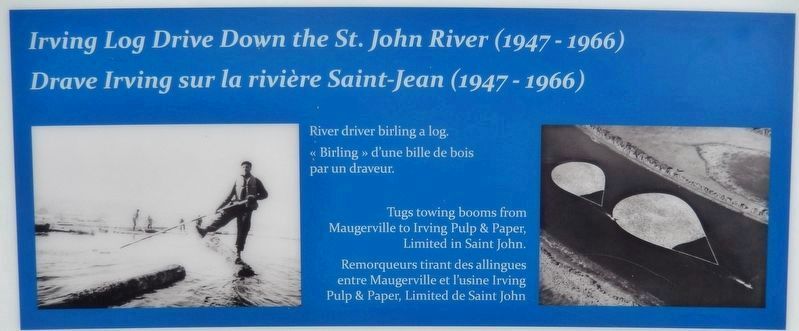
July 15, 2019
2. Marker detail: Irving Log Drive Down the St. John River (1947-1966)
Drave Irving sur la rivière Saint-Jean (1947-1966)
River driver birling a log. /
« Birling » d'une bille de bois par un draveur.
Tugs towing booms from Maugerville to Irving Pulp & Paper, Limited in Saint John. /
Remorqueurs tirant des allingues entre Maugerville et l'usine Irving Pulp & Paper, Limited de Saint John
River driver birling a log. /
« Birling » d'une bille de bois par un draveur.
Tugs towing booms from Maugerville to Irving Pulp & Paper, Limited in Saint John. /
Remorqueurs tirant des allingues entre Maugerville et l'usine Irving Pulp & Paper, Limited de Saint John
• Renamed Port Royal Pulp and Paper Company
• Produced bleached and unbleached sulphite
• Aging machinery and labour problems 1946 Saint John Sulphite Company
• K.C. Irving purchased the mill and its woodlands in Maine from the Lacroix brothers, March 14, 1946
• Renamed Saint John Sulphite Company, producing 85 tons daily
• New labor agreement by August 1946
• Construction began 1947, new equipment installed
1952 Irving Pulp & Paper, Limited
• Name changed by K.C. Irving to Irving Pulp & Paper, Limited
• Employment rose to 800 men
• River log drives used to bring wood to mill until dams built on river (1966) made this impossible
1960 - 1999
• New kraft mill built in 1960 for market pulp
• Produced 250 tons kraft pulp and 250 tons sulphite pulp a day when it came on-line in 1961
• 1970 expanded mill again, production per day increased to 600 tons of kraft and 250 tons of sulphite pulp
• 1977 sulphite pulp production ended because of environmental concern
• 1979 upgraded bleaching technology with environmentally-friendly chlorine dioxide, increased production
• 1981 teller scrubber placed on recovery boiler significantly reduced odour emissions from pulping process
• 1989 blow heat accumulator and non-condensable gas system further improved air quality
• 1990s Irving Pulp and Paper was the first pulp mill in the world to implement reverse osmosis to recycle effluent for internal use. In a major capital expansion (1995) it built a high rate aerobic treatment plant for the remaining mill effluent. It is the only pulp mill operating in North America (2009) that meets all environmental guidelines through internal pollution prevention and control
2000 - Present
• 2006 production reached 370,454 tons per year
• 2008 new lime kiln and SO2 scrubber systems were installed to further improve air quality and energy efficiency
• Production currently averages 1,036 tons of kraft pulp daily
1960 - 1987 Kimberly-Clark of Canada Limited
• Built tissue mill for parent roll production adjacent to Irving mill site
• Single tissue machine operation with additional manufacturing processes converted and produced household tissue products
• Official opening 1960
• Used pulp, electricity, steam and screened water from Irving Pulp and Paper mill
• Production 16,500 tons per year
1987 - Present Irving Tissue Company
• Kimberly-Clark of Canada mill sold to the Irvings, December 4, 1987
• Name changed to Irving Tissue Company
• 1988 second tissue machine installed
• 1989 major building expansion increased production of parent tissue rolls to 71,500 tons a year
• 2003 original tissue machine was rebuilt, production increased to 80,000 tons a year
• Continuous improvement now produces 83,000 tons tissue annually
• Irving Tissue Company produces a full range of premium consumer tissue parent rolls for manufacture by Irving Tissue (Moncton, NB) into branded (Majesta and Royale) and private label household tissue products: bathroom tissue, facial tissue, toweling and napkins
L'autre côté du site, où se trouve aujourd'hui l'usine Irving Pulp and Paper, est le théâtre des activités de l'usine depuis le début du XIXe siècle. À l'époque, ce site était connu sous le nom de Union Point.
Les usines à Union Point
1835 Scierie Cunnabells (aucune image connue)
• La scierie Cunnabells, la première connue à cet emplacement
• L'énergie marémotrice des Chutes réversibles est utilisée pour produire du bois d'œuvre
1850 (aucune image connue)
• Le colonel Goddard, du Maine, achète la scierie
• La puissance thermique est ajoutée à la scierie
• Le site est connu sous le nom de Union Point
1851 Scierie Cushing (aucune image connue)
• L'usine est vendue aux frères Cushing, qui lui donneront leur nom
• En 1855, l'usine est la proie des flammes et un neveu, George Cushing, la rebâtit
• Un incendie ravage de nouveau l'usine en 1869
Après 1870 Andre Cushing and Company Sawmill
• La scierie est reconstruite en bois par Andre Cushing
• Elle est renommée « Andrew Cushing and Company Sawmill »
1901 Cushing Sulphite Fibre Company
• L'usine est reconstruite en briques par des cousins plus jeunes
• Elle exporte principalement du bois d'œuvre sous le nouveau nom de Cushing Sulphite Fibre Company
• Une petite usine est ajoutée afin de produire des pâtes pour du papier de revêtement
• On y produit 7 tonnes anglaises de pâte écrue par jour
1906 Partington Pulp and Paper Company
• L'usine est vendue à Edward Partington, propriétaire non gérant d'usines de pâte à papier en Europe
• L'entreprise devient la Partington Pulp and Paper Company
• L'usine est agrandie pour y inclure la fabrication de pâte écrue au bisulfite vendue en ballots
• Elle contient l'un des plus gros séchoirs au Canada
• Le blanchisseur Belmer est construit pour un nouveau produit, la pâte blanchie
• La production déclarée atteint 45 tonnes anglaises par jour
• Une voie d'évitement reliant la voie ferrée principale à l'usine est construite (1911-1912) pour améliorer la livraison
• L'usine emploie alors 120 hommes, est dirigée localement et connaît du succès auprès des clients américains
1917 Nashwaak Pulp and Paper Company Limited
• L'usine est vendue à Nashwaak Pulp and Paper (propriétaires américains) et est renommée
• Chaque jour, l'usine fabrique 45 tonnes anglaises de pâte blanchie au bisulfite de qualité pour du papier édition de qualité supérieure
• L'usine Nashwaak ne parvient plus à répondre à la demande des clients
• Les propriétaires n'ont pas les moyens d'investir pour améliorer les installations
1921 Nashwaak Pulp and Paper Company Limited
• L'usine est vendue à Bryant Co. et à Oxford Pulp and Paper Co.
• Elle est exploitée par un président sur place pour les actionnaires
• En 1925, une deuxième machine est installée et produit 50 tonnes anglaises de pâte par jour
• Après le décès du président, l'usine connaît de nombreux problèmes et ferme ses portes en 1930
1932 Port Royal Pulp and Paper Company
• Les frères Lacroix, du Québec, achètent l'usine en faillite
• L'usine est renommée Port Royal Pulp and Paper Company
• Elle produit de la pâte blanchie et écrue au bisulfite
• La machinerie devient désuète et des problèmes de main-d'œuvre se manifestent
1946 Saint John Sulphite Company
• Le 14 mars 1946, K.C. Irving achète l'usine et ses terrains boisés dans le Maine auprès des frères Lacroix
• L'usine est renommée Saint John Sulphite Company et produit 85 tonnes anglaises par jour
• Une nouvelle convention collective est mise en place en août 1946
• Des travaux de construction débutent en 1947, et du nouvel équipement est installé
1952 Irving Pulp & Paper, Limited
• K.C. Irving change le nom de l'entreprise à Irving Pulp and Paper, Limited
• Le nombre d'employés passe à 800
• Le bois est transporté par flottage jusqu'à la scierie jusqu'à ce que des barrages construits sur la rivière (1966) rendent cette technique impossible
1960 - 1999
• Nouvelle usine de pâte kraft construite en 1960 pour produire de la pâte commercialisée
• À sa mise en service en 1961, l'usine fabrique 250 tonnes anglaises de pâte kraft et 250 tonnes anglaises de pâte au bisulfite par jour
• Nouvel agrandissement de l'usine en 1970; la production passe à 600 tonnes anglaises de pâte kraft et à 250 tonnes anglaises de pâte au bisulfite
• La production de pâte au bisulfite prend fin en 1977 en raison de préoccupations environnementales
• En 1979, la technologie de blanchiment devient plus écologique avec l'utilisation du dioxyde de chlore, et la production augmente
• En 1981, l'installation d'un épurateur Teller sur la chaudière de récupération réduit considérablement les odeurs émises par la fabrication des pâtes
• En 1989, un accumulateur de chaleur de décharge et une installation au gaz incondensable améliorent davantage la qualité de l'air
• Dans les années 1990, Irving Pulp and Paper, Limited est la première usine de pâte au monde à utiliser l'osmose inverse pour recycler les effluents à des fins internes. Dans le cadre d'un imposant projet d'agrandissement (1995), des installations de traitement aérobie à débit élevé sont construites pour les autres effluents de l'usine. Il s'agit de la seule usine de pâte en exploitation en Amérique du Nord (2009) qui respecte toutes les directives environnementales par la voie de la prévention et du contrôle de la pollution interne
Depuis 2000
• En 2006, la production atteint 370 454 tonnes anglaises par année
• En 2008, un nouveau four à chaux et des systèmes épurateurs de S02 sont installés pour améliorer encore plus la qualité de l'air et l'efficacité énergétique
• La production quotidienne moyenne de pâte kraft est de 1036 tonnes anglaises
1960 - 1987 Kimberly-Clark of Canada Limited
• Une usine de papier mince est construite pour produire des rouleaux de bobines mères à côté de l'usine Irving
• Les processus fonctionnels d'une machine à ouate et d'autres processus de fabrication sont convertis pour fabriquer des produits de papier domestique
• L'ouverture officielle a lieu en 1960
• L'usine utilise la pâte, l'électricité, la vapeur et l'eau tamisée de l'usine Irving Pulp and Paper
• La production est de 16 500 tonnes anglaises
par année
Depuis 1987 - Irving Tissue Company
• L'usine de Kimberly-Clark of Canada est vendue aux Irving, le 4 décembre 1987
• Son nom devient Irving Tissue Company
• 1988 Une seconde machine à ouate est installée
• 1989 Un agrandissement important du bâtiment augmente la production de rouleaux de bobines mères de papier mince à 71500 tonnes anglaises par année
• 2003 Grâce à la réfection de la machine à ouate initiale, la production passe à 80 000 tonnes anglaises par année
• L'amélioration continue permet aujourd'hui de produire 83 000 tonnes anglaises de papiers minces par année
• L'entreprise Irving Tissue Company produit un éventail complet de rouleaux de bobines mères de grande qualité aux fins d'expédition à Irving Tissue, à Moncton, au Nouveau-Brunswick, pour la fabrication de produits de papier domestique de marque (Majesta/Royale) et de marques privées : papier hygiénique, mouchoirs, essuie-tout et serviettes en papier
Erected by J.D. Irving, Limited.
Topics. This historical marker is listed in these topic lists: Environment • Industry & Commerce.
Location. 45° 15.441′ N, 66° 5.391′ W. Marker is in Saint John, New Brunswick, in Saint John County. Marker can be reached from Lancaster Avenue
, 0.2 kilometers east of Bridge Road (Route 100), on the left when traveling east. Marker is located along the walking path in Wolastoq Park, near the north end of the park, overlooking the Irving Pulp and Paper Mill complex beside the Saint John River. Touch for map. Marker is at or near this postal address: 211 Lancaster Avenue, Saint John NB E2M 2K8, Canada. Touch for directions.
Other nearby markers. At least 8 other markers are within walking distance of this marker. Françoise Marie Jacquelin (a few steps from this marker); Samuel de Champlain (within shouting distance of this marker); The New Community of Saint John (within shouting distance of this marker); Charles Gorman (within shouting distance of this marker); Koluskap and Beaver (within shouting distance of this marker); Rebels Attack (within shouting distance of this marker); William Kilby Reynolds (within shouting distance of this marker); Land of the Dawn (within shouting distance of this marker). Touch for a list and map of all markers in Saint John.
Credits. This page was last revised on November 3, 2022. It was originally submitted on October 31, 2019, by Cosmos Mariner of Cape Canaveral, Florida. This page has been viewed 210 times since then and 24 times this year. Photos: 1. submitted on November 4, 2019, by Cosmos Mariner of Cape Canaveral, Florida. 2. submitted on November 5, 2019, by Cosmos Mariner of Cape Canaveral, Florida. 3, 4, 5. submitted on November 4, 2019, by Cosmos Mariner of Cape Canaveral, Florida. 6, 7, 8. submitted on November 5, 2019, by Cosmos Mariner of Cape Canaveral, Florida. 9, 10. submitted on November 4, 2019, by Cosmos Mariner of Cape Canaveral, Florida.
